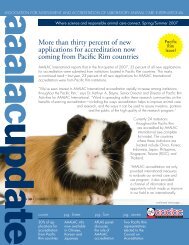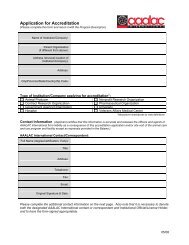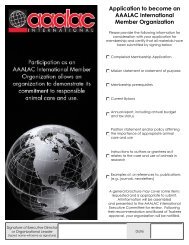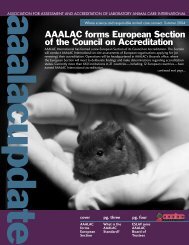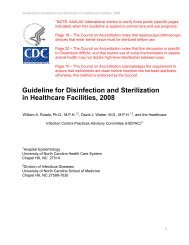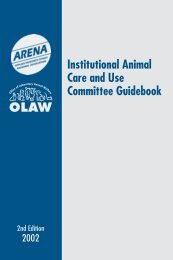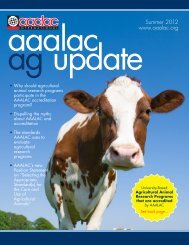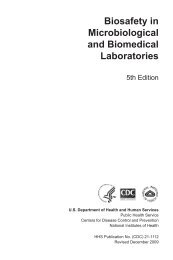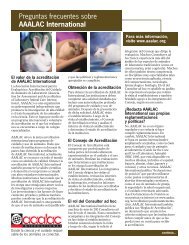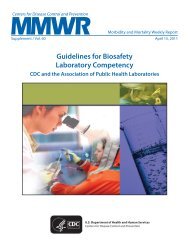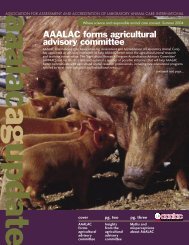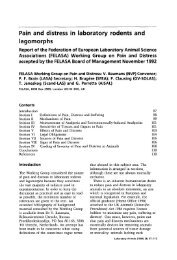2 CHAPTER 1The IACUC should meet at regular <strong>in</strong>tervals, as appropriate,to ensure that <strong>the</strong> use <strong>of</strong> agricultural animals<strong>in</strong> research <strong>and</strong> teach<strong>in</strong>g programs is humane, appropriate,<strong>and</strong> <strong>in</strong> accordance with this guide. Meet<strong>in</strong>gs <strong>of</strong><strong>the</strong> IACUC need not always be conducted <strong>in</strong> person.Electronic technology, <strong>in</strong>clud<strong>in</strong>g web-based or telecommunications,can allow <strong>the</strong> committee to function appropriately.Such communications must be held with aquorum <strong>of</strong> members <strong>in</strong> real time <strong>and</strong> provide <strong>the</strong> same<strong>in</strong>teractive opportunities as a face-to-face meet<strong>in</strong>g. Itis preferred that <strong>the</strong> IACUC work with <strong>in</strong>vestigatorsto resolve issues while ensur<strong>in</strong>g animal health. The IA-CUC is authorized to• review <strong>and</strong> approve or disapprove protocols<strong>and</strong> o<strong>the</strong>r proposed activities, or proposedsignificant changes <strong>in</strong> activities, related toagricultural animal care <strong>and</strong> use <strong>in</strong> research<strong>and</strong> teach<strong>in</strong>g;• conduct, at least twice a year, an <strong>in</strong>spection<strong>of</strong> agricultural animal facilities <strong>and</strong> studyareas <strong>and</strong> review <strong>of</strong> <strong>the</strong> overall agriculturalanimal care <strong>and</strong> use program, <strong>and</strong> to provide awritten report to <strong>the</strong> responsible <strong>in</strong>stitutional<strong>of</strong>ficial regard<strong>in</strong>g <strong>the</strong> <strong>in</strong>stitution’s compliancewith this guide;• <strong>in</strong>vestigate concerns, compla<strong>in</strong>ts, or reports <strong>of</strong>noncompliance <strong>in</strong>volv<strong>in</strong>g agricultural animalsat <strong>the</strong> facility;• suspend an activity <strong>in</strong>volv<strong>in</strong>g agriculturalanimals when it is not <strong>in</strong> compliance withapproved protocols or written operat<strong>in</strong>gprocedures (see section on Written Operat<strong>in</strong>gProcedures);• make recommendations regard<strong>in</strong>g <strong>the</strong>development <strong>and</strong> implementation <strong>of</strong><strong>in</strong>stitutional policies <strong>and</strong> procedures t<strong>of</strong>acilitate, support, <strong>and</strong> monitor <strong>the</strong> humane<strong>and</strong> appropriate use <strong>of</strong> animals <strong>in</strong> agriculturalresearch <strong>and</strong> teach<strong>in</strong>g as well as any o<strong>the</strong>raspect <strong>of</strong> <strong>the</strong> agricultural animal careprogram; <strong>and</strong>• per<strong>for</strong>m o<strong>the</strong>r functions as may be requiredby <strong>in</strong>stitutional need <strong>and</strong> by applicable laws,regulations, <strong>and</strong> policies.O<strong>the</strong>r useful <strong>in</strong><strong>for</strong>mation about IACUC functionscan be found <strong>in</strong> <strong>the</strong> Institutional Animal <strong>Care</strong> <strong>and</strong> <strong>Use</strong>Committee <strong>Guide</strong>book (ARENA/OLAW, 2002), <strong>the</strong>Public Health Service Policy on Humane <strong>Care</strong> <strong>and</strong> <strong>Use</strong><strong>of</strong> Laboratory <strong>Animals</strong> (PHS, 2002), <strong>and</strong> Silverman etal. (2006).PROTOCOL REVIEWThe review <strong>of</strong> research <strong>and</strong> teach<strong>in</strong>g activities us<strong>in</strong>ganimals is one <strong>of</strong> <strong>the</strong> most important functions <strong>of</strong> <strong>the</strong>IACUC. Protocols describ<strong>in</strong>g <strong>the</strong>se activities must bereviewed be<strong>for</strong>e <strong>the</strong> <strong>in</strong>itiation <strong>of</strong> <strong>the</strong> research or teach<strong>in</strong>gactivity to determ<strong>in</strong>e whe<strong>the</strong>r <strong>the</strong> proposed care<strong>and</strong> use <strong>of</strong> animals is appropriate <strong>and</strong> humane. Approval<strong>of</strong> <strong>the</strong> protocol may be granted, withheld pend<strong>in</strong>gmodifications, or denied. The IACUC should per<strong>for</strong>ma complete review at least once every three years,with additional cont<strong>in</strong>u<strong>in</strong>g reviews if <strong>and</strong> when deemednecessary by <strong>the</strong> IACUC. The follow<strong>in</strong>g topics shouldbe considered <strong>in</strong> <strong>the</strong> preparation <strong>and</strong> review <strong>of</strong> animalcare protocols:• Objectives <strong>and</strong> significance <strong>of</strong> <strong>the</strong> research orteach<strong>in</strong>g activity;• Unnecessary duplication <strong>of</strong> previous studies;• Availability or appropriateness <strong>of</strong> alternativeprocedures or models (e.g., less <strong>in</strong>vasiveprocedures, cell or tissue culture, or computersimulations) <strong>for</strong> <strong>the</strong> proposed research orteach<strong>in</strong>g activity. It should be noted, however,that h<strong>and</strong>s-on tra<strong>in</strong><strong>in</strong>g <strong>in</strong>volv<strong>in</strong>g animalsis a particularly important component <strong>of</strong>agricultural research <strong>and</strong> teach<strong>in</strong>g;• Aspects <strong>of</strong> <strong>the</strong> proposed experiment ordemonstration hav<strong>in</strong>g to do directly withanimal care <strong>and</strong> use, <strong>in</strong>clud<strong>in</strong>g justification<strong>for</strong> <strong>the</strong> species <strong>and</strong> (or) stra<strong>in</strong> <strong>of</strong> animal used;justification <strong>for</strong> <strong>the</strong> number <strong>of</strong> animals used;<strong>and</strong> a description <strong>of</strong> procedures that maycause discom<strong>for</strong>t, distress, or pa<strong>in</strong> <strong>and</strong> <strong>of</strong>methods <strong>of</strong> alleviation <strong>in</strong>clud<strong>in</strong>g anes<strong>the</strong>sia,analgesia, tranquilizers, <strong>and</strong> nonpharmacologicmeans, as well as justification <strong>for</strong> anyprocedures that <strong>in</strong>volve unalleviated pa<strong>in</strong>,discom<strong>for</strong>t, or distress;• Appropriateness <strong>of</strong> procedures <strong>and</strong> postproceduralcare;• Criteria <strong>and</strong> process <strong>for</strong> timely <strong>in</strong>tervention,removal <strong>of</strong> animals from a study, or euthanasiaif pa<strong>in</strong>ful <strong>and</strong> stressful outcomes areanticipated;• Unusual husb<strong>and</strong>ry requirements (Note:describ<strong>in</strong>g a procedure as a “st<strong>and</strong>ard farmpractice” may be acceptable if <strong>the</strong> <strong>in</strong>stitution’swritten operat<strong>in</strong>g procedure is be<strong>in</strong>g usedor if <strong>the</strong> practice is needed to serve as anappropriate control);• Aspects <strong>of</strong> animal husb<strong>and</strong>ry not coveredunder written operat<strong>in</strong>g procedures (seesection on Written Operat<strong>in</strong>g Procedures);• Method <strong>of</strong> euthanasia or disposition <strong>of</strong> <strong>the</strong>animal; <strong>and</strong>• Responsibilities, tra<strong>in</strong><strong>in</strong>g, <strong>and</strong> qualifications <strong>of</strong> <strong>the</strong>researchers, teachers, students, <strong>and</strong> animal carepersonnel <strong>in</strong>volved <strong>in</strong> <strong>the</strong> proposed activities.The US Government Pr<strong>in</strong>ciples <strong>for</strong> <strong>the</strong> Utilization<strong>and</strong> <strong>Care</strong> <strong>of</strong> Vertebrate <strong>Animals</strong> <strong>Use</strong>d <strong>in</strong> Test<strong>in</strong>g, <strong>Research</strong>,<strong>and</strong> Tra<strong>in</strong><strong>in</strong>g (Appendix 1 <strong>of</strong> this guide) state
that “Procedures <strong>in</strong>volv<strong>in</strong>g animals should be designed<strong>and</strong> per<strong>for</strong>med with due consideration <strong>of</strong> <strong>the</strong>ir relevanceto human or animal health, <strong>the</strong> advancement <strong>of</strong> knowledge,or <strong>the</strong> good <strong>of</strong> society.” Because IACUCs are notord<strong>in</strong>arily constituted to function as scientific peer-reviewcommittees, <strong>the</strong> IACUC should be judicious <strong>in</strong>review<strong>in</strong>g <strong>the</strong> merit <strong>of</strong> proposed research <strong>and</strong> teach<strong>in</strong>gactivities (Mann <strong>and</strong> Prentice, 2004). Institutionsshould consider develop<strong>in</strong>g o<strong>the</strong>r mechanisms <strong>for</strong> peermerit review <strong>of</strong> research projects that have not alreadybeen reviewed by outside agencies. Although qualifiedpeer review <strong>of</strong> research <strong>and</strong> teach<strong>in</strong>g is important toconsider, such peer review does not elim<strong>in</strong>ate <strong>the</strong> need<strong>for</strong> <strong>the</strong> IACUC to thoughtfully review animal use.Institutions must develop policies <strong>for</strong> animal care <strong>and</strong>use related to research conducted <strong>of</strong>f site as well asresearch us<strong>in</strong>g privately owned animals on <strong>and</strong> <strong>of</strong>f site.The fact that research is conducted <strong>of</strong>f site does notlessen <strong>the</strong> responsibility <strong>of</strong> <strong>the</strong> <strong>in</strong>stitution to assure appropriate<strong>and</strong> humane animal care <strong>and</strong> use.IACUCs are encouraged to work with <strong>in</strong>vestigatorsto help <strong>the</strong>m ref<strong>in</strong>e <strong>the</strong>ir protocols <strong>and</strong> proposed animalcare <strong>and</strong> use practices.The common acceptance <strong>and</strong> use <strong>in</strong> animal agriculture<strong>of</strong> a production system, management practice, orrout<strong>in</strong>e procedure does not reduce <strong>the</strong> responsibility <strong>of</strong>every animal user to follow applicable laws, regulations,<strong>and</strong> policies, <strong>in</strong>clud<strong>in</strong>g <strong>the</strong> st<strong>and</strong>ards outl<strong>in</strong>ed <strong>in</strong> thisguide. Exceptions to some provisions, however, may bejustifiable to obta<strong>in</strong> new knowledge or to demonstratemethods commonly used <strong>in</strong> commercial agriculturalanimal production. For example, applied research <strong>and</strong>teach<strong>in</strong>g may require <strong>the</strong> use <strong>of</strong> production practicesthat are consistent with those currently <strong>in</strong> use <strong>in</strong> <strong>the</strong>appropriate <strong>in</strong>dustry even though those practices differfrom those outl<strong>in</strong>ed <strong>in</strong> this guide; also, research <strong>and</strong>teach<strong>in</strong>g deal<strong>in</strong>g with <strong>in</strong>fectious diseases, tox<strong>in</strong>s, orproducts <strong>of</strong> biotechnology may require special facilities.Exceptions to this guide should be stated explicitly <strong>in</strong>research <strong>and</strong> teach<strong>in</strong>g protocols <strong>and</strong> be reviewed <strong>and</strong>approved by <strong>the</strong> IACUC.WRITTEN OPERATINGPROCEDURESIt is important to develop written policies or procedures<strong>for</strong> animal care <strong>and</strong> husb<strong>and</strong>ry <strong>in</strong> <strong>the</strong> <strong>for</strong>m <strong>of</strong>written operat<strong>in</strong>g procedures <strong>for</strong> each operat<strong>in</strong>g unit<strong>in</strong> <strong>the</strong> program. The IACUC must review <strong>and</strong> approveall written operat<strong>in</strong>g procedures <strong>in</strong>volv<strong>in</strong>g <strong>the</strong> potentialto cause pa<strong>in</strong> or distress <strong>and</strong> should review all writtenoperat<strong>in</strong>g procedures perta<strong>in</strong><strong>in</strong>g to animal care <strong>and</strong>husb<strong>and</strong>ry. The written procedures must be filed <strong>in</strong> <strong>the</strong>appropriate adm<strong>in</strong>istrative <strong>of</strong>fice <strong>and</strong> <strong>in</strong> locations accessibleto those <strong>in</strong>dividuals <strong>in</strong>volved <strong>in</strong> carry<strong>in</strong>g out<strong>the</strong> designated procedures <strong>and</strong> must be monitored regularlyby personnel designated by <strong>the</strong> <strong>in</strong>stitution.INSTITUTIONAL POLICIESThere are certa<strong>in</strong> commercial husb<strong>and</strong>ry practicesrout<strong>in</strong>ely carried out on agricultural animals that maycause temporary discom<strong>for</strong>t or pa<strong>in</strong>. These st<strong>and</strong>ardagricultural practices (see Chapter 3 <strong>and</strong> Chapters 6to 11) need not necessarily be described separately <strong>for</strong>each study, experiment, or demonstration, but are acceptableas written operat<strong>in</strong>g procedures provided that<strong>the</strong> practices 1) are warranted to susta<strong>in</strong> <strong>the</strong> long-termwelfare <strong>of</strong> <strong>the</strong> animal <strong>and</strong>(or) <strong>the</strong> animal’s caretakersor h<strong>and</strong>lers; 2) are per<strong>for</strong>med by or under <strong>the</strong> directsupervision <strong>of</strong> capable, tra<strong>in</strong>ed, <strong>and</strong> experienced personnel;<strong>and</strong> 3) are per<strong>for</strong>med with precautions taken toreduce pa<strong>in</strong>, stress, <strong>and</strong> <strong>in</strong>fection. The written operat<strong>in</strong>gprocedures <strong>for</strong> alleviat<strong>in</strong>g pa<strong>in</strong> <strong>and</strong> distress shouldbe reviewed <strong>and</strong> approved by <strong>the</strong> IACUC.Husb<strong>and</strong>ry procedures <strong>and</strong> production methods atagricultural research facilities should be revised as researchdemonstrates improvements. <strong>Research</strong> on improvedmethods <strong>and</strong> procedures is encouraged.ANIMAL HEALTH CAREAdequate health care <strong>and</strong> records <strong>the</strong>re<strong>of</strong> must beprovided <strong>for</strong> all agricultural animals used <strong>in</strong> research<strong>and</strong> teach<strong>in</strong>g (see Chapter 2: <strong>Agricultural</strong> AnimalHealth <strong>Care</strong>). Institutional requirements will determ<strong>in</strong>ewhe<strong>the</strong>r full-time, part-time, or consult<strong>in</strong>g veter<strong>in</strong>aryservices are appropriate.BIOSECURITYIt is essential that <strong>the</strong> agricultural animal care staffma<strong>in</strong>ta<strong>in</strong> a high st<strong>and</strong>ard <strong>of</strong> biosecurity to protect <strong>the</strong>animals from pathogenic organisms that can be transferredby humans. For additional details on biosecurityissues, see Chapter 3: Husb<strong>and</strong>ry, Hous<strong>in</strong>g, <strong>and</strong> Biosecurity.PERSONNEL QUALIFICATIONSIt is <strong>the</strong> responsibility <strong>of</strong> <strong>the</strong> <strong>in</strong>stitution to ensurethat scientists, agricultural animal care staff, students,<strong>and</strong> o<strong>the</strong>r <strong>in</strong>dividuals who care <strong>for</strong> or use agriculturalanimals are qualified to do so through tra<strong>in</strong><strong>in</strong>g or experience.Appropriate supervision should be provided topersonnel until <strong>the</strong>ir competency is assured. Tra<strong>in</strong><strong>in</strong>gprograms should be tailored to <strong>in</strong>stitutional animal userneeds but provide <strong>in</strong><strong>for</strong>mation about <strong>the</strong> humane care<strong>and</strong> use <strong>of</strong> agricultural animals, <strong>in</strong>clud<strong>in</strong>g, if applicable,1) husb<strong>and</strong>ry needs, proper h<strong>and</strong>l<strong>in</strong>g, surgical procedures,<strong>and</strong> pre- <strong>and</strong> post-procedural care; 2) methods<strong>for</strong> m<strong>in</strong>imiz<strong>in</strong>g <strong>the</strong> number <strong>of</strong> animals used <strong>and</strong> techniques<strong>for</strong> m<strong>in</strong>imiz<strong>in</strong>g pa<strong>in</strong> <strong>and</strong> distress, <strong>in</strong>clud<strong>in</strong>g <strong>the</strong>proper use <strong>of</strong> anes<strong>the</strong>tics, analgesics, tranquilizers, <strong>and</strong>nonpharmocologic methods; 3) methods <strong>for</strong> report<strong>in</strong>gdeficiencies <strong>in</strong> <strong>the</strong> animal care program; 4) use <strong>of</strong> <strong>in</strong><strong>for</strong>mationservices such as <strong>the</strong> Animal Welfare In<strong>for</strong>ma-3
- Page 1 and 2: Guide for the Care and Useof Agricu
- Page 3 and 4: Guide Revision Committees for the F
- Page 5 and 6: Chapter 6: Beef Cattle 61Facilities
- Page 7: PrefaceThis is the third edition of
- Page 12 and 13: 4 CHAPTER 1tion Center at the Natio
- Page 14 and 15: 6 CHAPTER 1Disposition of Animal Cl
- Page 16 and 17: Chapter 2: Agricultural Animal Heal
- Page 18 and 19: 10 CHAPTER 2and behavioral health e
- Page 20 and 21: 12 CHAPTER 2care attendants or rese
- Page 22 and 23: 14 CHAPTER 2exposed to these chemic
- Page 24 and 25: Chapter 3: Husbandry, Housing, and
- Page 26 and 27: 18 CHAPTER 3Most agricultural anima
- Page 28 and 29: 20 CHAPTER 3gases, particulates, an
- Page 30 and 31: 22 CHAPTER 3in pairs or groups when
- Page 32 and 33: 24 CHAPTER 3screened with 1.3-cm (0
- Page 34 and 35: 26 CHAPTER 3priate, and institution
- Page 36 and 37: 28 CHAPTER 3ings and Deliberations.
- Page 38 and 39: Chapter 4: Environmental Enrichment
- Page 40 and 41: 32 CHAPTER 4(Feh and de Mazieres, 1
- Page 42 and 43: 34 CHAPTER 4Substrate: The provisio
- Page 44 and 45: 36 CHAPTER 4mize regrouping and soc
- Page 46 and 47: 38 CHAPTER 4not especially attracte
- Page 48 and 49: 40 CHAPTER 4Croney, C. C., K. M. Ad
- Page 50 and 51: 42 CHAPTER 4Meunier-Salaün, M. C.,
- Page 52 and 53: 44 CHAPTER 4Wilson, S. C., F. M. Mi
- Page 54 and 55: 46 CHAPTER 5dling facility in the f
- Page 56 and 57: 48 CHAPTER 5Table 5-1. Visual distr
- Page 58 and 59: 50 CHAPTER 5Animals should be handl
- Page 60 and 61:
52 CHAPTER 5be given during conditi
- Page 62 and 63:
54 CHAPTER 5mercial broiler farms,
- Page 64 and 65:
56 CHAPTER 5The condition of the an
- Page 66 and 67:
58 CHAPTER 5Arnold, G. W. 1977. An
- Page 68 and 69:
60 CHAPTER 5for veterinary and husb
- Page 70 and 71:
62 CHAPTER 6managers of confined ca
- Page 72 and 73:
64 CHAPTER 6Cold housing can be pro
- Page 74 and 75:
66 CHAPTER 6HUSBANDRYAdequate care
- Page 76 and 77:
68 CHAPTER 6ately to perform a caes
- Page 78 and 79:
70 CHAPTER 6minimum amount of time
- Page 80 and 81:
72 CHAPTER 6Ensminger, M. E. 1970.
- Page 82 and 83:
Chapter 7: Dairy CattleDairy cattle
- Page 84 and 85:
76 CHAPTER 7Table 7-1. Recommended
- Page 86 and 87:
78 CHAPTER 7ties should be provided
- Page 88 and 89:
80 CHAPTER 7quent feeding, and exce
- Page 90 and 91:
82 CHAPTER 7hanced sensitivity to h
- Page 92 and 93:
84 CHAPTER 7effective for removing
- Page 94 and 95:
86 CHAPTER 7Albright, J. L. 1978. S
- Page 96 and 97:
88 CHAPTER 7Murphy, M. R., C. L. Da
- Page 98 and 99:
Chapter 8: HorsesMost horses are us
- Page 100 and 101:
92 CHAPTER 8Temperature and Ventila
- Page 102 and 103:
94 CHAPTER 8tritional programs for
- Page 104 and 105:
96 CHAPTER 8WaterClean water should
- Page 106 and 107:
98 CHAPTER 8bots (Gastrophilus inte
- Page 108 and 109:
100 CHAPTER 8STANDARD AGRICULTURALP
- Page 110 and 111:
102 CHAPTER 8of Animals. C. McGowan
- Page 112 and 113:
104 CHAPTER 9dom of movement, runni
- Page 114 and 115:
106 CHAPTER 92006). Developing bree
- Page 116 and 117:
108 CHAPTER 9Table 9-3. Minimum fee
- Page 118 and 119:
110 CHAPTER 9Table 9-7. Minimum dri
- Page 120 and 121:
112 CHAPTER 9Table 9-10. Minimum fl
- Page 122 and 123:
114 CHAPTER 9Table 9-12. Minimum fl
- Page 124 and 125:
116 CHAPTER 9ery effort should be m
- Page 126 and 127:
118 CHAPTER 9guides, available from
- Page 128 and 129:
120 CHAPTER 9nutritive pecking decr
- Page 130 and 131:
122 CHAPTER 9rapidly fragmented by
- Page 132 and 133:
124 CHAPTER 9Brambell, F. W. R. 196
- Page 134 and 135:
126 CHAPTER 9Hughes, B. O., and M.
- Page 136 and 137:
128 CHAPTER 9chickens grown with tw
- Page 138 and 139:
130 CHAPTER 10Table 10-1. Recommend
- Page 140 and 141:
132 CHAPTER 10prevented or minimize
- Page 142 and 143:
134 CHAPTER 10and well-being (Matte
- Page 144 and 145:
136 CHAPTER 10via colostrum (de la
- Page 146 and 147:
138 CHAPTER 10thoroughly at the beg
- Page 148 and 149:
140 CHAPTER 10Ames, D. R., J. E. Ne
- Page 150 and 151:
142 CHAPTER 102006. Semen and repro
- Page 152 and 153:
144 CHAPTER 11Table 11-1. Recommend
- Page 154 and 155:
146 CHAPTER 11vided in the creep ar
- Page 156 and 157:
148 CHAPTER 11Table 11-2. Minimum f
- Page 158 and 159:
150 CHAPTER 11are kept in small gro
- Page 160 and 161:
152 CHAPTER 11sonable to consolidat
- Page 162 and 163:
154 CHAPTER 11Blackshaw, J. K., F.
- Page 164 and 165:
156 CHAPTER 11populations structure
- Page 166 and 167:
Appendix 2Table A-1. Zoonotic disea
- Page 168 and 169:
IndexAAABP (American Association of
- Page 170 and 171:
162 INDEXcold climates. See also te
- Page 172 and 173:
164 INDEXdairy, 137disbudding of, 1
- Page 174 and 175:
166 INDEXmisters, 19mites, 98Model
- Page 176 and 177:
168 INDEXin horse stalls, 90in poul



